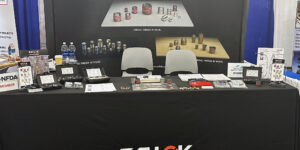TRENDS IN INDUSTRIAL PARTS CLEANING
From necessary evil to added value factor, it is difficult to think of another process in the manufacturing chain that has seen such a meteoric rise as industrial parts cleaning. And the cleaning results demanded by all sectors of industry…
Posted: March 26, 2010
From necessary evil to added value factor, it is difficult to think of another process in the manufacturing chain that has seen such a meteoric rise as industrial parts cleaning. And the cleaning results demanded by all sectors of industry ? especially the automotive industry ? are not only high, they look set to become even higher. Which processes, media and measures will be needed in the future to meet the required cleaning quality?
When it is the wrong place, even the lightest of soiling can have dire consequences, from a large number of production rejects, through costly reworking, right up to production stoppages. Parts cleaning therefore makes a significant contribution to the added value chain in the manufacture of components.
Indeed, technical cleanness requirements for workpieces has increased sharply in the last few years, and there is no end in sight. This presents both manufacturers and users of industrial cleaning technology with new challenges.
INDIVIDUAL PART CLEANING OR BATCH PROCESS
Sadly, there is no magic formula for achieving precisely defined residual soiling values on the surface of components. Each cleaning task needs an individually defined solution. Key factors in this regard are the material or combination of materials, the soiling, the geometry of the component, the degree of cleanness required in terms of both film and particulate soiling, and the production throughput. The appropriate process is derived from all these criteria.
For example, companies engaged in engine and gear manufacturing have already been using individual part cleaning for many years, as the geometry of various parts and the strict cleanness requirements make targeted treatment of channels, boreholes and surfaces necessary.
We can also see a tendency toward individual part cleaning in several other fields of the automotive supply industry. The reasons for this are stricter cleanness requirements as well as avoidance of damage due to unnecessary parts handling.
It is safe to assume that the ever increasing level of automation in modern manufacturing will lead to increased use of individual part cleaning, providing the process can run inline. An optimum workflow can only be guaranteed when the various manufacturing steps and intermediate cleaning between these steps are perfectly matched to one another. This involves bringing manufacturing steps and cleaning procedures together to form a technological process that, in certain circumstances, can be performed in a single unit.
Individual part cleaning is also set to increase in fields where it offers logistic advantages, for example if downstream processes require components to be in a specific position. Batch processes also have potential here, as they offer the advantage of high throughput in a relatively short time when cleaning mass-produced parts, thereby also representing a lower cost proportion of the total production costs of a workpiece.
COST AND TIME SAVINGS THROUGH FUNCTIONAL SURFACE CLEANING
The targeted cleaning of functional surfaces and component sections, such as sealing surfaces, laser-welded surfaces or also pre-assembled and preserved parts with CO2 snow jet, laser or plasma cleaning processes is currently something of a niche sector.
However, functional surface cleaning is set to become increasingly important. This is due to the often drastically different cleanness requirements of workpieces; for example, the need for a specific surface quality of defined parts or sections for downstream processing steps. In cases like these, classic water-based or solvent-based cleaning can often be very costly, as the entire component has to be cleaned to the strict standard of the functional section.
As cost pressure in manufacturing processes increases, targeted functional surface cleaning offers welcome savings, both in terms of time and costs. Another key advantage of having functional surface cleaning integrated into the manufacturing process is that the clean surface can be provided "just-in-time", therefore eliminating any measures to keep parts clean after cleaning and during transport.
EASY-TO-HANDLE CLEANING FLUIDS
When it comes to cleaning fluids, solvents and water-based fluids will continue to play an important part in future. However, alongside quality aspects, the economic and ecological requirements of the user will also help determine which cleaning solutions are used. The easiest fluids to handle are those with which multi-stage or combined cleaning processes, such as immersion cleaning, ultrasonic treatment and injection flood washing, can be performed.
With water-based fluids, the trend is moving toward cleaning solutions that are capable of removing heavy soiling at low temperatures. This leads to shorter treatment times and helps conserve energy and water due to the lower temperature.
With solvent-based cleaning, the introduction of polar solvents has helped make the cleaning processes both faster and easier. These fluids are capable of removing both non-polar soiling, such as grease or oil, and polar contamination, such as water-based coolants and lubricants, salts, burrs and other particulate material in a single wash.
Cleaning fluid treatment is also set to become increasingly important. Perfectly matched filtration and separator systems extend the useful life of the cleaning fluids, thereby increasing the quality, profitability and environmental friendliness of parts cleaning as a whole.
CLEANNESS TESTS BECOMING MORE IMPORTANT
Cleanness checks of material surfaces have become a significant part of quality-oriented manufacturing. Non-destructive methods of analysis with a high degree of accuracy and reliability are needed to check the cleanness of surfaces on components and functional areas. These methods must also be able to work fast, preferably at full production speed. Only then can deviations from specified values be detected quickly, allowing rapid reactions.
– – – – – – – – – – – – – – – – – – – – – – – – – – – – – – – – – – – – – – – – –
Doris Schulz is a technical writer for Schulz Press, Martin-Luther-Straße 39,
70825 Korntal, Germany, +49 (0)711 854085, Fax: +49 (0)711 815895,
ds@pressetextschulz.de.









